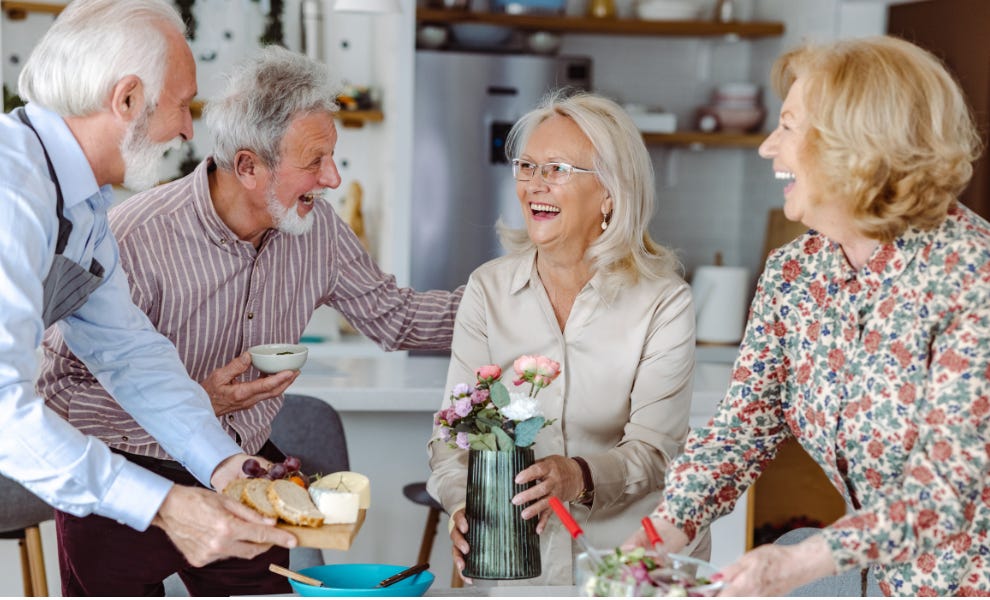The 5 Levels of Connectedness For Longevity
Men, Women and Marriage
Everything is Connected, Being Connected is Everything
Scientific researchers studying longevity have found that five levels of social connection were experienced by those who lived the longest lives and the levels are marriage, family, friends, wider social network, and religion or shared belief system. To have four of the five levels of connection was still found to be of benefit to longevity.
Level 1. Marriage
Being married is good for your physical and mental health, studies show. Single people who have good social networks can also be happy, and those who decide to leave an unhappy marriage can find happiness if they have sound support. Unmarried people who live with a partner tend to show better outcomes in studies than those living alone. What about men’s and women’s different lived experiences of marriage or long-term commitment? Are they similar?
Research reveals that for men it’s a positive to be married. A major study in America found that married men are healthier than those who don’t marry or whose marriages end in divorce or widowhood. They live longer than men who don’t marry and the longer they are married, the greater their survival chances are, than those who are unmarried. Men living with a wife enjoy the best of all health.
Bereavement studies show that men are more likely than women to experience illness and disability after losing a spouse. It seems that having been looked after by their wife and before that, their mother, they become unable to look after their own nutritional needs and their overall health, although grief itself can debilitate, resulting in loneliness, depression and social isolation.
So it becomes clear that men would enjoy more positive outcomes if they took control of their own health, especially when single. Research shows that unmarried, divorced and widowed men don’t eat well or exercise and are more likely to engage in unhealthy behaviors such as smoking and drinking alcohol. So, if marriage benefits men more than women, I wondered what science says about women and wedlock.
Women have long been more unhappy with their marital state than men. Around seventy percent of divorces are initiated by women. Not so long ago, society frowned on divorce and unhappy couples stayed together for the sake of avoiding social ostracism and the financial costs involved, especially for women who were not encouraged to work outside the home. Today, women are more likely to work and can be self-supporting. It’s not always easy with children, but it can be done. Also, divorce has become part of the norm, so leaving a marriage does not mean social alienation.
The type of behavior women were expected to accept by their spouses is no longer tolerated. Men are more likely to commit adultery and engage in risky behavior. It has been mooted that women have high expectations of marriage and are too soon to act when it doesn’t live up to their expectations. Perhaps the finding of ‘the one’ still lingers in a girl’s upbringing, judging by the popularity of the number of ‘fairy tale’ weddings that still take place.
Men and women are socialized differently. Men have been brought up to concentrate on their own needs and to consider material contributions more important, as they still expect to be the breadwinner. Women, in contrast, are raised to put the needs of others first and to prioritize empathy and caring. This can lead to a conflict of expectations. When ‘Mr Right’ doesn’t turn out to be as helpful around the home as a woman expects and lacks understanding of his wife’s annoyance at this, problems arise in the relationship. Marriage means compromise for both partners, but more women are concluding that it’s no longer worth the sacrifices required of them.
The Office for National Statistics in the UK reveals from censuses that marriage and divorce are on the rise at age sixty-five and over. The number of older people getting married went up by forty-six percent in a decade. This has been attributed to the post-war baby boomers who make up twenty percent of the population and are living longer. Almost all the brides and grooms aged over sixty-five in 2014 were divorcees, widows, or widowers, and only eight percent were getting married for the first time.
Research shows that staying married when the relationship is good is worth it for both parties when it comes to longevity. However, for the women who leave unhappy marriages, at whatever age, they can still find happiness through their network of friends. I can vouch for this as I left a marriage in my early seventies and now live happily without a life partner, surrounded by not only friends but a close family. Women are better at maintaining their friendships, even during marriage than men, and this can be a crucial factor in their health and wellbeing after the loss of a spouse.
Level 2. Family
The next level of connectedness was to family. Those who had close family members were found to live longer than those who didn’t. The long-living people in the Blue Zone regions lived either with, or very close to, family members and there were no retirement homes in the vicinity. The mixing of different generations would be good for all concerned, and interactions with young people would be stimulating for the elderly family members, giving them a strong sense of connection to life.
Perhaps until the middle of the twentieth century, the trend was towards single-family homes. However, the number of multigenerational living arrangements in the UK and the US, as well as other developed countries, is growing. With women working and childcare costs high, the help of grandparents is essential. That and the fact that fewer young people just can’t afford to live independently means that they have little choice but to continue living with their parents. So both generations involved are experiencing several benefits: financial, psychological and social. The older members of these families have been shown in studies to have a longer survival rate than those living on their own.
Level 3. Friends
Having a network of good, supportive friends is vital at any age, but particularly in later years, especially if you live alone. The quality of the relationships you have with friends is essential and often develops over time. The quantity is irrelevant if the few that you have are real and with whom you can be yourself. You may have hundreds of Facebook and Instagram “friends” but they don’t count when it comes to quality. These superficial social media connections can lead to a feeling of insecurity and exacerbate loneliness.
Nurturing your relationships with close friends is important for your mental health. It has been said that friends are the family we choose instead of being born into. Close friends provide unconditional love that not all families share. They stand by you regardless of what you’re going through and they are always there for you, offering support and inspiration, sometimes supplying a reality check in a situation we are not seeing clearly. I value my friends; we are nearly all online and email or phone each other but ensure that we meet regularly in person at least monthly.
However, hanging on to friendships when they no longer supply the support you need but cause you to be unhappy is no longer productive in your life. It’s better to face up to the fact that it’s time to call it a day. No longer enjoying a friendship can lead to stressful situations which can be detrimental to your mental, and consequently, physical, health.
Level 4. Wider Social Network
Next in the levels of connection is a wider social network, as found in activity groups. They are often where new friends are made. The groups might be arts and crafts sessions, sports groups, book clubs, writing circles, knitting circles, keep fit groups, yoga, pilates, choirs, study groups for those who like to continue to learn as they age, etc. Over the years, I have been a member of many of these and I’ve made most of my friends through them.
We get to know more people through activity groups and enjoy social interaction, even though they are not on the same level of intimacy as our close friends. We share a familiarity and a common experience in the group’s activity. Over time, one or two of these people may join our inner circle. For those that don’t, their very familiarity can make us feel part of a community. They help us feel rooted.
Level 5. Religion or Shared Beliefs.
Every culture on earth gathers in social groups; it’s a natural human instinct to do so. The long-living people studied for their longevity usually enjoyed being part of a religious community. The feeling of connection in such a community must be life-enhancing. As someone who is not religious, I wonder if the activities enacted in the churches provide much of the glue for the communities, rather than the religion itself.
The congregations meet regularly; they sing and pray together, often they provide support networks as well as social networks and they share a set of common beliefs. Some of the groups mentioned earlier have regular meetings, shared group activities and common beliefs, so could provide a similar connection as churches, perhaps. Being politically active is a result of shared beliefs and belonging to a political party can also provide the shared activities that enable a person to feel fully connected.
Having five levels of connectedness, then, is important for longevity. However, being connected in fewer ways is not detrimental to your long-term health if you are fulfilled and don’t feel lonely. Lack of feeling of connection results in chronic loneliness, which predicts increased mortality. Being proactive in building networks is important for your long-term mental and physical health.
I hope you enjoyed reading this post, if so don’t forget to press the heart icon to give it a like. Was it helpful? What do you make of the findings of these studies? I’d love to know in the Comments.






Connectedness is important at any age, but particularly as we get older. It's also harder to maintain connections with friends as we age. I love that you don't necessarily have to check all the boxes to have the longevity benefits from being connected.
A great read packed with relevant information on how we humans do and can connect. Thank you.